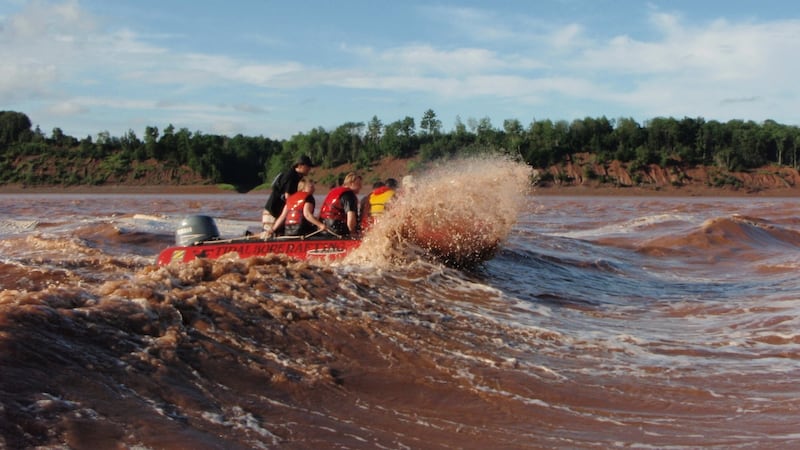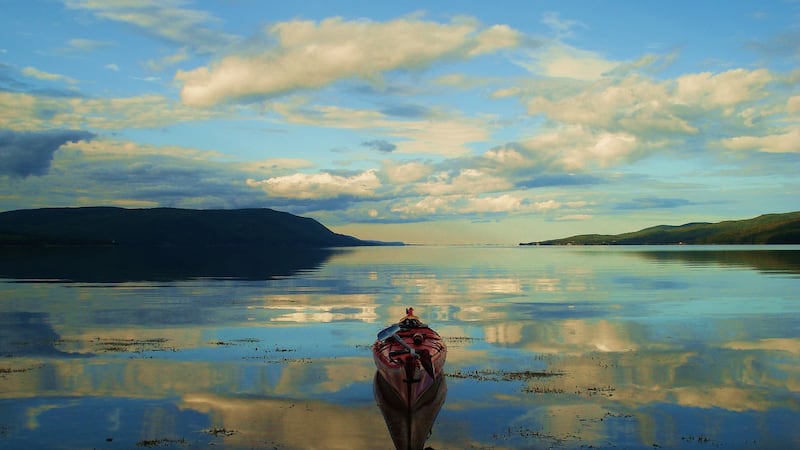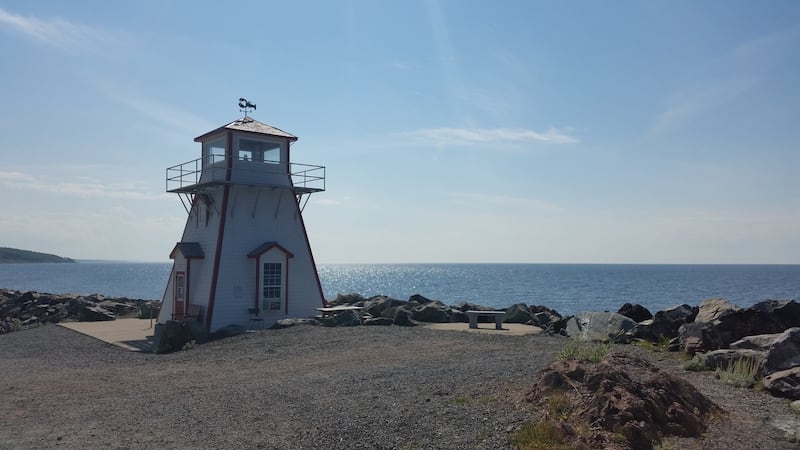Something about Nova Scotia's dramatic coastline, sandy beaches and lush hills has a look of Ireland to it, like a distant cousin with your grandmother's colouring. And with a long history of immigration from Ireland and Scotland in the 18th and 19th centuries, it shares more than a few Irish mannerisms too. But Nova Scotia has a personality that is all its own.
About the same size as Ireland but with a quarter of the population, "Canada's ocean playground" cottoned on to the lure of the tourist trail long before Fáilte Ireland cut the ribbon our own 2,500km stretch of coastal exploration. In the 1920s and 1930s, mass automobile ownership changed the face of tourism in these parts, breeding a new kind of tourist beyond the elite who could afford the rail or steamship fares to get here. The government took notice, and by 1932 the Cabot Trailwas complete, a 298km stretch of highway around the northern tip of the province's Cape Breton island, taking in spectacular coastal views and the Highlands National Park.
Named after Genoese explorer John Cabot, the area was first settled by the aboriginal Micmac, who still have a presence here today, albeit eclipsed by the French and Scottish immigrants who came here from the 17th century onwards. The traditions of both are strong throughout the county, with French still the first language for many and Gaelic traditions widely celebrated. The blend of cultures makes for a quaint combination of Gaeltacht summers and French camping trips that teenagers will roll their eyes at in the present and remember fondly in the future.
0 of 10
Scenic drives
The only way to see Canada's second-smallest province is by car, and the peninsula has a trail for every mood: the Ceilidh Trail, the Sunrise Trail, the Marine Drive, the Lighthouse Route – and any number of shorter "scenic drives". It's an adventure on the beaten track for nature lovers, nerds and anyone whose idea of a holiday is eating their own weight in delicious seafood.
Lobster appears on just about every menu: stuffed in scallops at the atmospheric Five Fishermen in Halifax (fivefishermen.com – make sure to ask about the resident ghosts); packed into spring rolls at the family-friendly Pictou Lodge (pictoulodge.com); smothered in cheese curds and gravy on a bed of fries a la "poutine" at the roadside Rusty Anchor (therustyanchorrestaurant.com) overlooking Pleasant Bay on the Cabot trail.
The tourist board has even come up with a "lobster trail" (novascotia.com/explore/road-trips/unique-lobster-dishes) of the province's most creative crustacean cuisine. It's enough to make you regret adopting just two baby lobsters at the Pictou Lobster Hatchery, where the mission is to replenish dwindling lobster populations through a canny combination of marine biology, excitable tourists (kids and big kids will love it) and unfeasibly friendly student summer volunteers.
Overheard at the Lobster Bar in Pictou, another friendly local unconvincingly suggests a couple of inquiring tourists might find nightlife in the nearby town of New Glasgow. This is an early-to-bed, early-to-rise kind of place, and all the more charming for it. Pictou Lodge, the local beachfront holiday resort, is refreshingly quiet, with chalets aplenty but not a disco or a ceilidh as far as the toe can tap. Just peaceful sea views, beautiful sunrises and the sound of children making holiday buddies as dusk falls.
Downtown Pictou is a quaint affair, the Hector Heritage Quay its main attraction. With a population of about 3,500, it gets its name from its original Micmac inhabitants, who called the area Pictook, meaning "exploding gas", possibly a sound that came from coal fields in the region. But by the end of the 18th century the Hector would sail in from Scotland, bringing with it 170 Scottish highlanders and making Pictou the "birthplace of New Scotland", a heritage proudly celebrated today with a full-size replica of the ship on the dockside (treat yourself to some of Mrs McGregor's Shortbread afterwards: mrsmacgregors.com).
Simple life
These pleasant little towns with friendly locals are dotted all over Nova Scotia, and there's seemingly no end to their proud traditions, museums, crafts and culture. It's hard to escape the feeling of being on an extended school tour – in the best possible way. What "la dolce vita" is to Italians, the simple life is to Nova Scotians. Visitors can enjoy working farms of every variety, from sheep (lismoresheepfarmwoolshop.com) to lavender (lavendercanada.com). Museums cover everything from fisheries (northumberlandfisheriesmuseum.com) and to Celtic music (celticmusiccentre.com) and a working grist mill (balmoralgristmill.novascotia.ca). You can even watch a traditional "milling frolic", among other Celtic traditions demonstrated at Colaisde na Gàidhlig (gaeliccollege.edu).

But let's face it, a milling frolic isn't everyone's idea of a good time. So for those who get their kicks from the great outdoors, Nova Scotia offers endless activities, many of them making the most of the water. From Pleasant Bay, on the Cabot Trail, Captain Mark (whaleandsealcruise.com) offers whale-watching boat trips along this stunning coastline, with views of the Cape Breton Highlands National Park.
The trips last about two hours, longer if the whales are shy at first, but there’s plenty to watch while you’re waiting, including playful seals and majestic eagles, and all the while with Captain Mark’s affable and informative commentary on the local landscape and fisheries. July is the time when pilot whales migrate here in great numbers, staying until November, and it is these enchanting creatures that come by the dozen to play and feed – and even sleep their half-sleep, the captain tells us – around our boat.
For something a bit more active, North River Kayak (northriverkayak.com), near Beddeck, offers kayaking packages that range from leisurely to intensive – and they even have something for romantics! Owner and operator Angelo Spinazzola started the company more than 24 years ago, the idea inspired by summers spent on the river as a child. After some basic training on dry land, the half-day tour gets under way, a round trip of six or seven kilometres through the unspoilt region of St Ann's Bay, passing huge eyries and American bald eagles perched overhead.
A pit stop at a tiny beach, with a small waterfall beyond, provides an opportunity to enjoy some chocolate chai tea and Angelo’s homemade rhubarb jam slathered on thick slices of banana bread from a local bakery. Angelo and his crew also arrange overnight “roughing it and romance” packages for kayakers who want to spend the night at this heavenly little spot, providing a campfire, waterside dinner for two, tent and sleeping mats, breakfast, and a guided kayak escort back the following morning. But for this group it was time to head back, a heavy downpour bringing a romance of its own to the leisurely return paddle.

Staying in the water – or rather hurtling headfirst down a mudhill into it – Nova Scotia’s Bay of Fundy is famous for its tidal bores, which twice daily transform otherwise calm and peaceful rivers into raging rapids.
At the Tidal Bore Raft Resort (raftingcanada.ca) on the Shubenacadie river, owners Steve and Alicia have made it their business to squeeze as much fun out of this natural phenomenon as it's possible for grown men and women (and older children) to have while sitting atop a rib holding on for dear life (take the back seat for a while for the full experience). You'll laugh, you'll scream, you'll get soaked, you'll rediscover the joy of rolling around in mud, and you'll leave feeling 10 years younger.
Back on dry land, Nova Scotia offers any number of walks and hikes for every fitness level (hikenovascotia.ca). For history lovers, Uniacke Estate (uniacke.novascotia.ca) is a short drive from Halifax and offers a number of walking trails around the 19th-century house built by Richard John Uniacke. Hailing from Cork, Uniacke fought in the American revolution, later sought to emancipate slaves in Nova Scotia, and devoted 49 years to public service in the province. But even for those with a passing interest in the history of this estate the sweeping lake views and tranquil setting alone are worth the visit.
Skyline Trail
For something more dramatic, the Skyline Trail is not to be missed. This spectacular hike leads to a headland cliff overlooking the rugged coast that forms the Cabot Trail. From the viewing deck you can watch for whales in the Gulf of St. Lawrence and the area is inhabited by moose, bald eagles, bears and boreal birds. A two- to three-hour hike will take you on a nine-kilometre loop along a boardwalk that is suitable for most skill levels (be careful with children around the cliffs and give the moose a wide berth) and that allows for the protection of the delicate flora and fauna along its route.
And this is Nova Scotia in a nutshell: a province that has long been aware of the appeal of its landscape, its culture and its traditions, but that maintains a balance between attracting tourists and protecting those things it holds dear. The charm of the place is the pride taken in every little quirk, like the replica of the original Arisaig Point lighthouse in Antigonish, which now doubles as a "lobster interpretive centre" that also sells ice cream in the summer months. It has a sense of humour, too: take Jean's store in Chéticamp, where the Acadian tradition of rug hooking is preserved and a sign out front shouts "PROUD TO BE HOOKERS" at passing cars (proudtobehookers.com). And it has a sense of mischief, like the Lantern Walk Through Time, a forest walk like no other, led by an otherworldly guide and following the footsteps of Ingonish's earliest settlers.
Even back at Halifax, the start and end point of this road trip, the province's capital has lost nothing of that Nova Scotian charm. With a population of about 400,000, the city is built around an eight-point 18th-century citadel (where you can be transported back to the 1800s as a "soldier for the day") and along a harbour, where bars and restaurants vie for the view with a permanent indoor farmers' market (halifaxfarmersmarket.com). Like Galway's taller cousin with fewer roundabouts, this is a chilled-out university town; and, as with the rest of Nova Scotia, the sea's influence can be seen in everything from the colossal Halifax Shipyard to the Fairview Cemetery, the final resting place for more than 100 victims of the Titanic sinking.
A bus tour is a great way to get your bearings and find out more about its colourful history (try ambassatours.com) but it's a walkable city with some beautiful architecture – start and end at the harbour and lose yourself in between. Two or three days is plenty of time in the capital before starting your road trip and losing yourself in the rest of Nova Scotia's ocean playground.

Getting there and getting around
The best months to visit are June, July and August, when temperatures are a pleasant 20-30 degrees. July is a great month for festivals, including Pride and the jazz festival in Halifax, and the Lobster Carnival in Pictou.
ASL Airlines France (aslairlines.fr/en) operates a weekly direct flight from Dublin to Halifax from June 28th until the end of August, departing both cities on Wednesdays. Prices starting from about €570 return, including taxes and baggage.
Renting a car is the only way to see the province and a number of rental companies operate from Halifax airport (Thrifty costs from about €310 per week including taxes for a compact car – thrifty.com). Check out novascotia.com/explore/road-trips for some suggested itineraries.
Accommodation
Halifax heritage – in the heart of historic Halifax and spread across three heritage townhouses, the Halliburton (thehalliburton.com) is a few minutes' walk from the harbour and an ideal spot from which to explore the city. From about €100 a room per night. (Try dinner at their Stories restaurant (storiesdining.com) and cocktails on the terrace.).
Highland fling – from the clifftop Keltic Lodge (kelticlodge.ca) golf and spa retreat, the views of Cape Smokey and the surrounding Breton highlands are nothing short of majestic. The lodge is said to be haunted by former owner Julia Corson – spend some time here and you'll see why she was so reluctant to leave! Rooms from about €170 a room per night.
Seaside getaway – families in particular will love Pictou Lodge (pictoulodge.com), with beautiful views of the Northumberland shore. The private beach is peaceful and perfect for a sunset dip, and there's plenty to keep the kids occupied, including a heated outdoor pool, kayaks, bonfires, a playground and outdoor games, as well as oceanside dining at the lodge. Prices from about €150 a room per night.
Nova Scotia caters for all tastes and budgets, with plenty of options dotted along its well-worn trails. Other highlights include the scenic Glenora Inn & Distillery (glenoradistillery.com) from about €95 a room per night; self-catering log cabins at the Tidal Bore Rafting Resort, from about €115 a night for a one-bed; and the Silver Dart Lodge near Baddeck and overlooking the Bras d'Or Lakes (don't miss a swim in this calm "inland sea") from about €180 a night for the one-night getaway package, including breakfast and dinner for two.





















